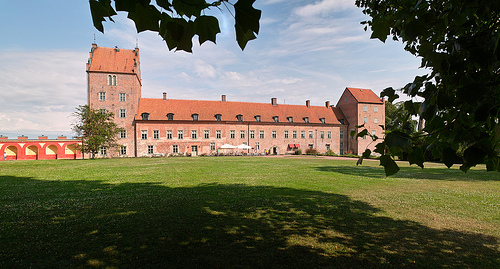

Location: Scania Map
Constructed: 13th century (initially as a monastery)
Bäckaskog Castle is a medieval castle situated in the Kiaby parish in the town of Kristianstad. Bäckaskog Castle was originally constructed in the 13th century as a Roman Catholic monastery on a picturesque isthmus between Oppmannasjon (Oppmannasjon lake) and Ivosjon (Ivo lake). During Reformation the monastery was closed in 1537 and it went into possession of a Danish crown. However former church of the monastery was preserved to out days. In 1658 the castle was abandoned after the Sweden captured these lands. From 1685 the head of local Swedish cavalry stayed here. In 1818 Bäckaskog Castle become one of many residences of the Swedish king. Today it is open as a hotel, restaurant and a conference center.
Bäckaskog was founded as a Premonstratensian monastery in the 13th
century. The monastic activity ceased during the Reformation in 1537,
when Bäckaskog was taken over by the Danish state. It was then a grant
to the families Ulfstand, Brahe, Bille and Parsberg. Finally, it was
transferred with ownership to the Ramel family. In 1684 it was withdrawn
to the Swedish crown by Charles XI. It then became the residence of the
colonel at the Southern Skåne Cavalry Regiment but was often leased out.
Among the owners, it is especially the field marshal Johan Christopher
Toll and Karl XV who beautified the castle and its surroundings. Oscar I
leased the property in 1845 and in 1853 handed over the contract to
Crown Prince Karl, later Charles XV. He was the owner of Bäckaskog until
his death in 1872. Crown Prince Fredrik of Denmark, later Fredrik VIII,
took over the property in 1885, but in 1900 left the contract to
Chamberlain Filip Stjernswärd.
Around 1924, Bäckaskog was leased
by Per Åkers (Nilsson) who was director of the Swedish-owned telephone
company in Poland. He had previously, until the revolution in 1917, been
director of it by e.g. LM Ericsson owned the telephone company in
Moscow, where he originally came as gymnastics director and then learned
Russian. He was the last to lease both the castle and agriculture and
lived at the castle for many years. A relative then took over the lease
of the farm.
In 1956, the castle was separated from agriculture.
The castle was leased by Gustav Ferlenius, who made Bäckaskog a popular
tourist destination. Since then, Bäckaskog is used for conferences and
courses and is open to the public. In 1996, the castle was bought by the
Swedish Property Agency.
Probably already belonged to a garden of the monastery that existed before the castle. Between 1820 and 1840, a landscape-style park was created for the castle. That part remains under the name of the wilderness park, but some original buildings such as an orangery and decorations were demolished in the early 20th century. Around 1950 and 1960, new parts of the park were created to increase visitors' knowledge. With the new parts of the park, information was conveyed about previous garden ideals and the names of the plants. New parts included an herb garden and a biblical garden. Due to significant success with rose cultivation, Bäckaskog's castle was nicknamed the rose's castle.
The children's
book "Rymlingen" by Åsa Storck (published in 1996 by the book publisher
Hegas) takes place at Bäckaskog's castle during the 14th century.
The TV program Stjärnorna på slottet was recorded at the castle
during the summer of 2012. Guests were Ewa Fröling, Robert Gustafsson,
Claes Malmberg, Barbro "Lill-Babs" Svensson and Philip Zandén. Also
during the summer of 2013, the program was recorded at Bäckaskog Castle.
Guests were Leif Andrée, Malena Ernman, Maria Lundqvist, Claes Månsson
and Lasse Åberg. In the summer of 2021, the program was also recorded at
Bäckaskog Castle for the third time. Guests were Carola Häggkvist, Per
Andersson, Marika Carlsson, David Lagercrantz and Grynet Molvig.